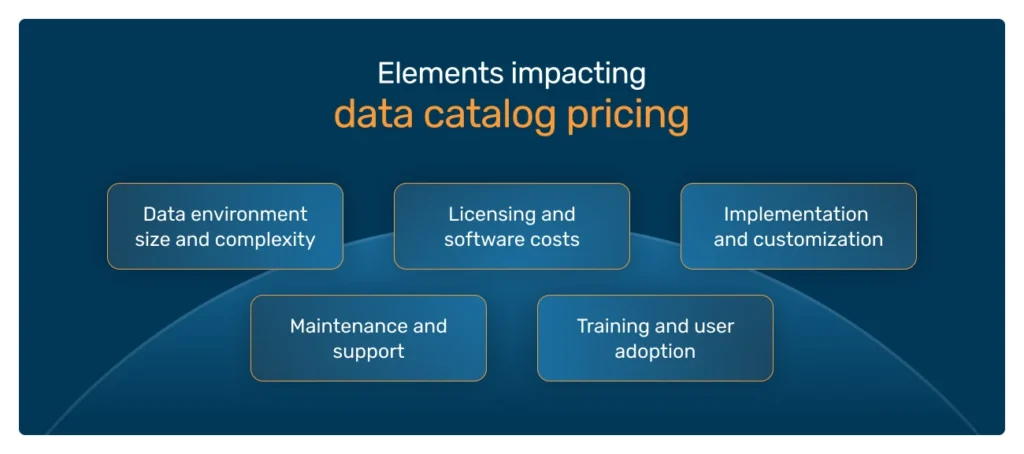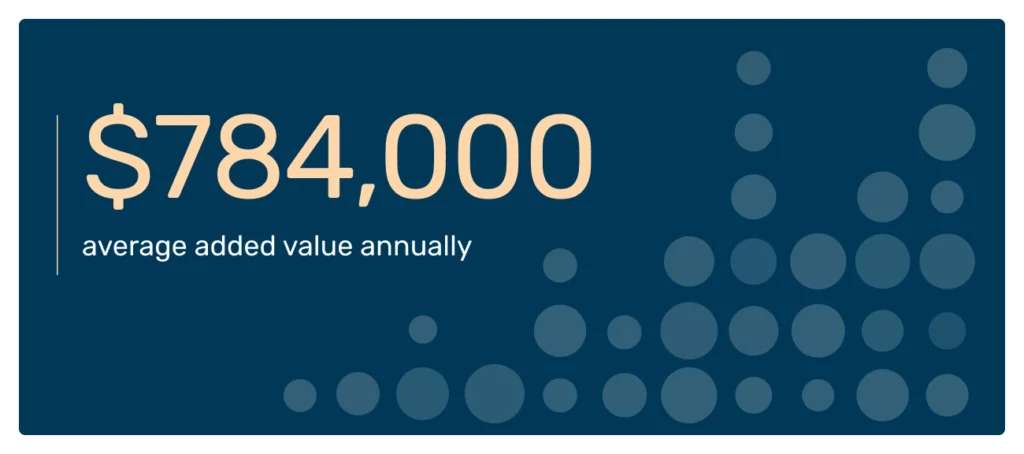If you’re planning to implement a data catalog, pricing is definitely on your mind as you research the available solutions. Here’s a handful of tips on what to look for and how to make the most of your data catalog investment from a team of experts who have been implementing data catalog solutions for over 8 years across more than 60 client projects.
What goes into data catalog pricing
Let’s make one essential thing clear first: data catalog pricing is rarely just the nominal cost of the data catalog software. In reality, there are many more elements associated with implementing a data catalog. Let’s break them down.
1. In-house vs. external team
We go into this subject in more detail in another article on building data catalogs. And the calculation here is not as simple as in-house = cheaper and outsourced = more expensive.
The final cost will depend on how experienced the people building the data catalog are, how well they know the platform you use for this (e.g. Collibra), and how many data catalogs they’ve built before. An experienced external team like Murdio, working with your team, can actually save you a lot of the cost and time implementing a data catalog, which is something to always keep in mind.
| Tip: We can help optimize the software setup from the start, so you don’t have to pay for features you don’t need, or for data assets that are obsolete or duplicate. Actually, there are plenty of areas like this where we know how to tweak Collibra so that you get the most value while cutting unnecessary costs. |
“What you pay for Collibra experts will depend on factors such as seniority, skillset, and industry certificates. For example, think of a Collibra Ranger like a full-stack software engineer. Their work will be more expensive, but they’ll also spend significantly less time solving more complex problems, so at the end of the day, you’ll actually get more value.” – Łukasz Banaszewski, Co-founder & Partner at Murdio, Collibra Ranger
2. The size and complexity of your data environment
If your organization has a relatively small and structured dataset, you can expect lower costs than those of a multinational enterprise dealing with petabytes of diverse, distributed data.
In general, the more data sources, integrations, and customizations you need, the more complex (and expensive) your data catalog implementation will be. (Though, again, hiring experienced people to do it can significantly reduce that complexity.)
3. Licensing and software costs
Most enterprise-grade data catalogs, including Collibra, operate on a subscription-based licensing model. Costs can vary depending on:
- Number of users, including creators and contributors (as these make the most difference to the final price)
- Number of data sources
- Specific modules you need
- On-premise vs. cloud-based deployment,
- Number of data assets
- Integrations
- Data stewardship
| Tip: Again, Murdio can help you optimize these, effectively lowering the software costs. For example, we know how to create workflows to bring down the number of creators or contributors, which can make a significant difference to what you’ll be paying. |
4. Implementation and customization
Buying a data catalog is one thing. Getting it up and running properly is another. While Collibra provides a robust platform out of the box, tailoring it to your specific business needs requires expertise.
This is exactly where implementation costs come in – whether it’s hiring an external consultancy (like Murdio) or building an in-house team to configure workflows, integrate systems, and align the catalog with your governance framework.
5. Maintenance and support
Once your data catalog is live, you’ll need to maintain it. This includes software updates, governance policy adjustments, and ongoing support.
Some vendors offer support as part of their licensing fees, while others charge a separate fee. You’ll also want to consider whether you have the internal resources to manage the catalog or if you’ll need external support.
| Tip: When working with external consultants for Collibra implementation, be sure to check the contract for vendor lock-ins. (We don’t have one at Murdio.)
Vendor lock-ins make you dependent on a vendor even when it no longer makes sense for your company or there are better/more cost-effective solutions out there. As a result, you might end up paying more for lower quality of service, because leaving might cost you even more. |
6. Training and user adoption
A data catalog is only valuable when actually used. Investing in training programs to help your team understand how to navigate, contribute to, and manage the catalog is actually an important piece of the puzzle.
This can mean additional costs for workshops, certifications, or onboarding sessions with data experts.

The most common pricing models for data catalogs
Here are some of the most commonly seen data catalog pricing models:
Subscription-based pricing
Most enterprise data catalogs, including Collibra, operate on an annual or multi-year subscription model. Pricing is often based on different tiers/packages, which typically depend on factors like the number of users, modules included, and data volume.
Usage-based pricing
Some data catalog solutions offer usage-based pricing, where you pay based on the number of data assets cataloged or the level of API usage. This model can be cost-effective for smaller organizations, but can become expensive at scale.
Perpetual licensing
Less common today, some vendors offer a one-time licensing fee for the software, with additional costs for maintenance and updates. This model might be appealing to companies looking for a predictable, long-term investment.
Services-based pricing
For organizations that need significant customization, vendors or consultancies like Murdio offer a services-based model, where pricing is tied to the level of implementation and ongoing support required.

How much should you expect to pay for an enterprise data catalog?
Now, we can’t give you exact pricing without knowing all the specifics from the earlier sections of this article. That would be irresponsible of us.
A lot depends on the pricing of the platform you’re going to use, how you’re going to implement it, along with the size of your company, the volume of data you’re going to catalog and the number of data sources, customizations and integrations with other software, etc.
So, because this involves quite complex calculations, trying to give you exact numbers here would be guesswork at best.
(We would love to do some proper calculations, though, if you reach out to talk to us about your data catalog needs.)
How to evaluate the ROI of a data catalog investment
Don’t think a data catalog is just another software expense. It’s an investment that can drive significant business value. So, while you get quotes from data catalog software and implementation teams, compare them against your business goals and KPIs that you should also have in place.
To measure if it’s worth it, look at some of the following elements:
- How much time you’re going to save, e.g. on data discovery. Count in the reduced burden on specialized IT teams when non-technical users can easily access trusted data.
- The increase in productivity that follows from time savings, increased data quality and easier collaboration, as teams can get much more done when they don’t waste their time searching for and comparing data or having to wait until someone else gets them the data they need.
- More accurate business decisions now based on more accurate data.
- Heavily reduced compliance risks, eliminating possible fines.
- Reduced data storage costs as you eliminate obsolete and duplicate data that often takes up a lot of space.
- With specialized experts like Murdio, you can also further bring down the costs, for example, by implementing workflows that allow to reduce the number of users included in the software license.
When IDC looked at the average business value enterprises get out of using Collibra, they calculated $784,000 gained annually on average, coming from the above savings and productivity gains. Of course, this number doesn’t just come from using a data catalog alone, but Collibra in general, with all its additional features and capabilities.

Still, the ROI is undeniably positive. And if you use Collibra to its full potential, you can expect substantial gains for your company.
Here’s an example of a Murdio client, a leading retailer in the DACH region, who we helped both reduce operating costs and improve efficiency by providing a Collibra Technical Implementation Team.
Which is why we highly recommend working with Collibra experts who know how to get maximum value from your data catalog investment.
What to consider when comparing data catalog pricing options
There are certainly several things you should pay attention to when considering data catalog software and implementation services, including answering the following questions:
- How scalable is the software solution? Can it grow with your organization?
- Does it support your existing tech stack and can it integrate with all the important software and data sources?
- Is it easy enough for your team to use, or will it sit unused, only generating costs? Do you have the resources to onboard people and increase adoption?
- What level of customer service and peer support is available?
- Can you test the product or demo it to understand the usability in your environment?
- What’s the total cost of ownership – licensing, implementation, training, customizations, and maintenance? Remember that licensing is just the initial cost when it comes to data catalogs.
How to optimize data catalog costs
We would argue that by far the most important thing that could save you a lot of money is working with experts in Collibra (or other data catalog software) who know where to look for optimization opportunities.
From our experience, it’s the implementation that’s key here. Murdio experts can solve issues in hours (or dare we say minutes) instead of days or sometimes weeks. This means you’ll get much faster to the data catalog software bringing your company actual gains instead of only being a licensing cost you need to pay for the duration of your contract.
We can also set you up with a Collibra data catalog, deploy it, integrate and customize plus maintain it long-term, so you get the whole package from one experienced vendor. (Without the lock-in, may we add. Though our experience shows our clients prefer to stay with us long-term, based on the benefits they get.)
Other places where you can look for optimizations include:
- Starting small with an MVP (e.g., with a data catalog for a single department within the company) and then tweaking and expanding as adoption grows.
- Taking a really close look at licensing options to make sure you’re paying exactly for what you need.
- Doubling down on adoption. A data catalog your team doesn’t want to use will likely only generate costs and no savings.
Want to get maximum value from your data catalog?
Chat with our experts about data catalog pricing, implementation, and all the features you need, and let’s make sure your company makes the most of your data catalog software.
Frequently asked questions
What is data catalog pricing?
Data catalog pricing is the cost of acquiring, implementing, and maintaining a data catalog solution. This includes elements such as:
- Data catalog software licensing
- Initial setup
- Integration with other data intelligence systems
- User training and onboarding
- Ongoing support.
What is included in a data catalog?
Depending on the available software features, a data catalog typically includes:
- Metadata management
- Data glossaries and business context
- Multi-user capabilities with ownership, access levels, and collaboration tools
- Data lineage tracking
- Governance policies
- Search and discovery tools
- Customizable dashboards
- Data product building capabilities
- Automated workflows
- Integrations with other data platforms
It’s important to note that, depending on the software you use, some features may come out of the box while others will require additional implementations and customizations.
What is the value of a data catalog?
The value of a data catalog depends largely on two things:
- The business needs you’re planning to meet using the data catalog
- The extent to which you can use its potential for your business.
In general, most companies use data catalogs to:
- Improve data governance processes
- Enhance data discoverability and usage
- Boost operational efficiency
- Ensure regulatory compliance and eliminate associated risks
Share this article
Related Articles
See all-

15 November 2025
| Collibra experts for hireWhat is Collibra Edge? A 2025 Explainer
-

15 November 2025
| Collibra experts for hireThe definitive guide to Collibra Data Lineage
-

3 November 2025
| Collibra experts for hireCase Study: Discovering, classifying and cataloging unstructured data for a European bank



